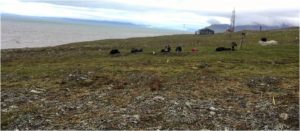On July 28th I returned to America after attending the Plant Functional Trait Course in Svalbard with a plethora of unexpected but appreciated information. For instance, I learned that many Norwegians find me ever-excited and hyper-outgoing, but most importantly, a fellow student informed me that I am a “handsome” lady—a fantastic fact to learn. In addition, I was able to learn about the two subjects I was most eager to: how questions cycle through the scientific process with a trait-based approach, and how to approach science communication.
This course demonstrated how a trait-based approach could address my desire to understand how ecosystems are responding to climate change. Additionally, it helped me better understand how environmental gradients can be used to simulate change. Gradients, whether they be elevation, nutrient, or other, can allow researchers to understand the conditions where traits are best adapted. My group and I wanted to understand how traits change along on two Svalbardian elevation gradients: the “control” gradient, and the “bird cliff” gradient. The presence of birds can produce nutrient gradients through nutrient deposition. Seabirds deposit ocean-derived nutrients into terrestrial ecosystems, so if a nutrient gradient does exist, traits will be more robust closer to the bird cliff.
Preliminary results reveal a bell curve pattern for plant height and leaf thickness in the control gradient, suggesting mid-elevation is most favorable to plant traits. We also found that plant height and leaf thickness greatly increased in plants closest to the bird cliffs. As stated, these results are not yet final, but analysis is ongoing. I still hope to understand how community composition responds along a gradient and to understand the role inter- and intraspecific variability play in these responses.
In addition to climate change research, I also want to pursue science communication, so I was also grateful for the chance for us usually insular scientists to get out into the community and interact with locals while collecting data. My experience with surveying mostly involved knocking on doors. Though a majority of those surveyed weren’t excited to take a survey about climate change perception, they seemed to bear it for our sake. It felt intrusive to appear at someone’s door with a request, but I believe that method gave us a random sample; however, next time I would make the survey shorter to spare the people who looked through the multi-page survey with trepidation.
The surveys demonstrated that the vast majority of Svalbardians believe climate change is occurring and caused by humans. In my home country of America, less than 60% believe that climate change is caused by humans. I was not surprised to find that more Svalbardians believe in climate change than do Americans, but I was surprised to discover that Svalbardians don’t feel threatened by climate change. The arctic is warming nearly twice as fast as other regions, and already experiencing the effects of climate change. People who did accept that climate change was a threat were concerned about the increasing severity of avalanches, which is likely one of the more life-threating and obvious effects of climate change.
This course gave me a diverse research experience that will profoundly aide my future research, where I will continue to use a trait-based approach to understand how abiotic factors influence plants and the future of our ecosystems. Participation in this course research was my first step to my final goal, so even though the days were long I stayed ever-excited and hyper-outgoing.


COM SPORTS PAGE?Après une saison très décevante dans laquelle les Los Angeles Lakers ont perdu un record de franchise de 55 matchs, l’équipe a engagé un nouvel entra?neur, Byron Scott.